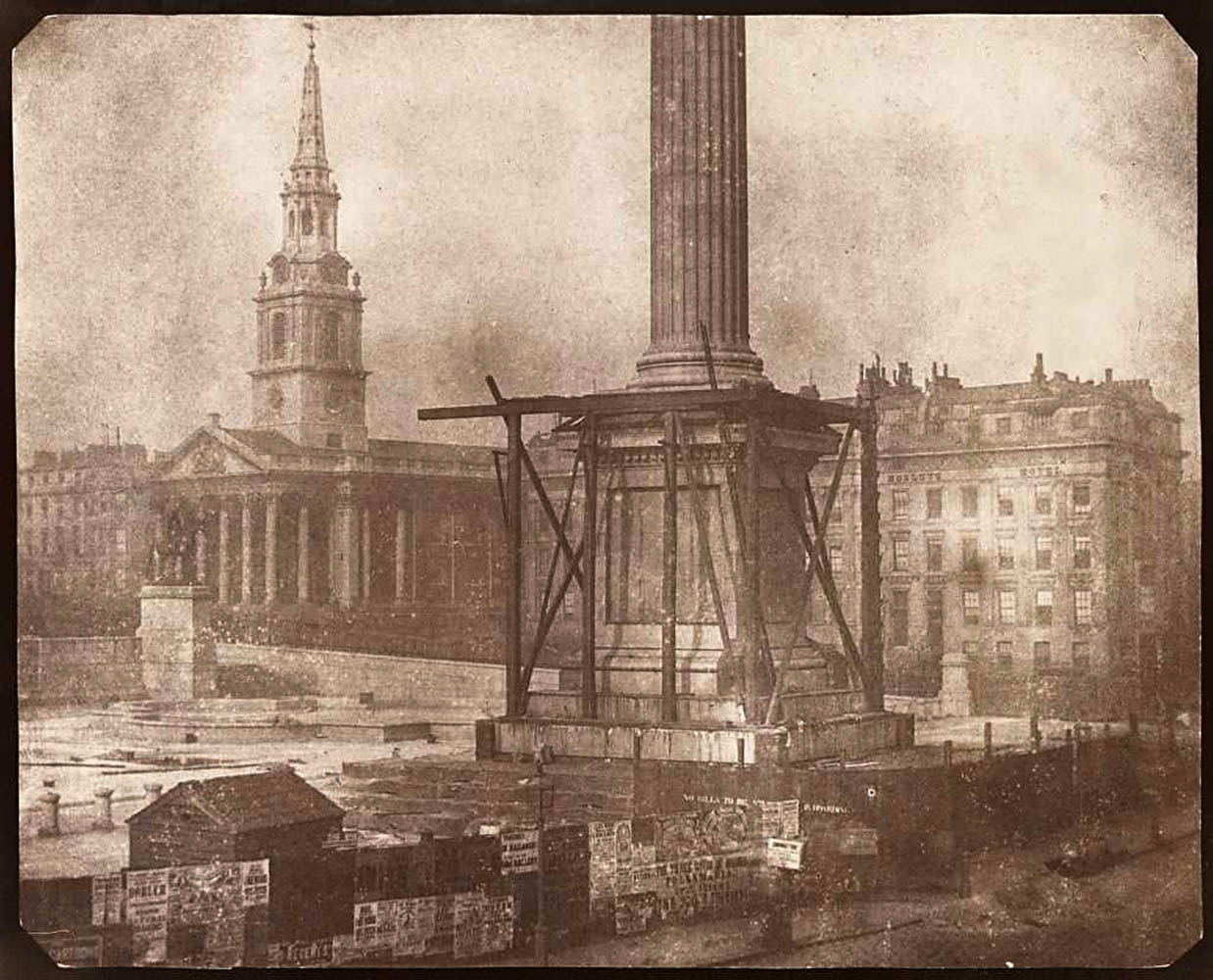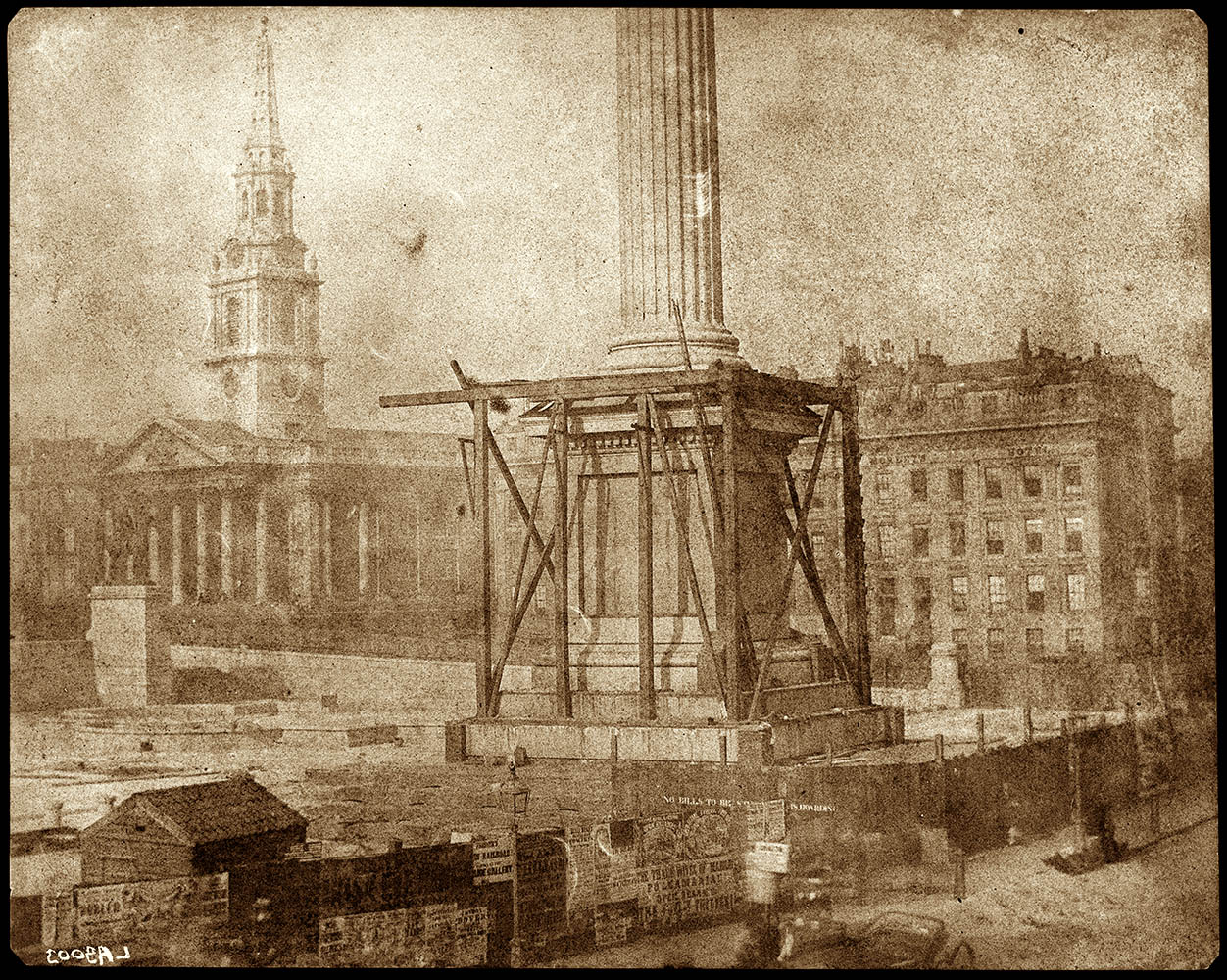.
This week offered so many possibilities that it seemed to be an embarrassment of riches. Cinco de Mayo is today – surely a clever writer could have drawn some parallel between the victory of the Mexicans over the French and the system of Talbot succeeding beyond that of Daguerre. But frankly, that is not a red herring that I enjoy or wish to encourage. Or we might have turned to the 40th anniversary of Star Wars, which debuted in 1977, one hundred years after Talbot’s death. Many of our discussions must seem centered on “a long time ago in a galaxy far, far away.” Surely Henry could have been worked into either of these themes, somehow.
However, this past Monday, the first of May, was May Day worldwide (and a cry of mayday in some places) and that immediately brought to mind another of my favourite Talbot images.
Trafalgar Square, Nelson Monument Under Construction,
the first week of April 1844
If one intentionally limited one’s knowledge, this would appear to be a fine if curious record of a busy scene of urban building and civic pride. Here is the base of the massive column being constructed to commemorate the hero of Trafalgar. Edward Hodges Baily’s sandstone statue of Admiral Horatio Nelson was incomplete, so at first the framing showing just the base might seem logical. A serendipitous patch of sunlight struggles through the fog to add relief to the base and St. Martin’s in the Field lends an air of dignity and stability.
In fact, the building of the monument was stalled at this point. With its building committee again running out of money, the government was forced to take over the project in 1844. Another decade was to pass before it was completed, inspiring Punch to publish a “Nelson Column Emeute”:
O’er Nelson’s Column, by a hoard concealed
All London cried to have the base revealed;
Those dismal hoards have shut it in for years….”
For our non-British readers, it might do to explain that ‘hoarding’ is the ring of rough-cut wood boards surrounding the base. But Punch’s “hoards” may well have had a double meaning, for the great fear of the 1840s throughout Europe was that of civil disobedience. Trafalgar Square was the largest urban public space created during this decade and there was much concern that it might spawn riots. The large round fountains, so beloved of tourists and pigeons today, were not meant as amenities. They were designed to break up the space and discourage the rapid coordinated movement of crowds.
Morley’s Hotel (in the background on the right) was re-named South Africa House in the 1930s and perhaps some of our older readers recall, as I do, participating in the almost daily demonstrations against Apartheid that took place there in the 1960s-1980s.
Henry Talbot lived in a period of revolution. Talbot’s sensitive management of Lacock had kept the Wiltshire area fairly quiet during the unrest of the 1830s, but given the unusual framing of this photograph, was he photographing the monument or was he documenting the wariness of his age about the creation of a hotbed of unrest? In addition to the crowd-breaking fountains, the column’s base was raised in the hopes of making it more difficult for use as an impromptu speaker’s platform (the popular Barbary Lions were not added until 1867). As it happened, the feared Chartist rallies never occurred in the Square. However, perhaps ironically, the first of the greatly feared rallies occurred, but it was four years after this photograph and a protest over income tax.
Trafalgar Square, Nelson Monument Under Construction,
variant, with carriage (digital print)
There is a lesser-known close variant of this photograph, virtually identical but presumably rejected because of the intrusion of the carriage.
(digital prints)
There are three other known cousins of this photograph, taken at dates unknown at present, but they have a very different emphasis. I think that these variants argue for Talbot’s greater concern for the open space than for a war hero’s memorial.
With the National Gallery anchoring one end and public artworks now encouraged, Trafalgar Square is a popular tourist attraction but also remains as a tempting place for protest. As it happened, I traveled from Oxford to Paddington Station the morning of 21 January this year. As an old Vietnam War protester, I could not help but be cheered and excited by the carriages crowded with people young and old carrying their protest signs. I’m told that there were at least 10,000 people participating in the Women’s March and that pretty well lines up with my assessment of the crowd.
What would Henry Talbot have thought of that? He wouldn’t have been surprised at the size and fervor of the crowd, although I suspect he would have had a distaste for this type of action. But as a former Member of the First Reform Parliament, I expect he would have understood the reason why so many people were outraged and he would have had some sympathies.
So was Talbot’s intent for this photograph closer to the celebratory spirit of May Day, or more a cry of ‘mayday’?
 “NO BILLS TO BE POSTED”
“NO BILLS TO BE POSTED”
And now for a bit of visual history, almost from “a long time ago in a galaxy far, far away.” Back in the analogue dark ages of 1999, the J Paul Getty Museum generously loaned their sophisticated equipment and highly trained photographers to attempt to tease as much detail as possible out of the posters. In our wondrous digital age, it is probably time to repeat this exercise in hopes of doing slightly better, but the Getty brought things down pretty close to the paper fibre level. The bronze reliefs would not be attached to the base until 1849 and Sir Francis Chantrey’s statue of George IV at the left had just been put in place on 24 February 1844. Yet the wonderfully jumbled collection of posters and announcements decorating the hoardings are still our most precise means of dating. Considered to be graffiti at the time (the Times sarcastically commented that “for the great edification of the sight seeing world, and doubtless to the great happiness of that useful class of Her Majesty’s subjects – the bill stickers – a wooden barrier … may still tell of Jullien’s concerts, Adelphi and Circus attractions…so that the most elegant and complete square in Europe, with its massive and finely-chiselled granite…its handsome fountains and fine jet of water…will be disfigured and disgraced by another unsightly hoard.” Closely examining the posters and railway bills, the Theatre Royal Lyceum had just regained its old name on 29 January 1844 and launched its season with “Open Sesame” on Easter Monday, 8 April. Meeting with Antoine Claudet, Henry Talbot was in London from 31 March through 7 April. Did they team up for this image? In any case, thanks to the posters, we can date this photograph to that precise week.
Larry J Schaaf
• Questions or Comments? Please contact digitalsupport@bodleian.ox.ac.uk • WHFT, Trafalgar Square, Nelson Monument Under Construction, salted paper print from a calotype negative, first week of April 1844, Houston Museum of Fine Arts, Manfred Heiting Collection, 2004.691; Schaaf 3662. • Punch, v. 14, 1848, p. 110. • It took more than 500 police to disperse the disorderly income tax crowd. Although the palisades around Nelson’s Column were torn down, there were no serious injuries. On the same day, riots that did claim lives took place in Glasgow, Edinburgh, Liverpool and elsewhere in Britain. Talbot’s sister Horatia was in Italy, trapped by the revolution there – he wrote to her about the “great riots in Glasgow, tumultuous lampbreaking in London – open rebellion preached at Dublin….” WHFT to Horatia Feilding, 8 March 1848; Talbot Correspondence Project Document no. 06117. A month later, a true Chartist rally held in Kennington Common was recorded by the daguerreotype. See Gail Buckland, First Photographs: People, Places and Phenomena as Captured for the First Time by the Camera (New York: Macmillan Publishing Co., 1980), p. 22. • WHFT, Trafalgar Square, Nelson Monument Under Construction, digitalprint from a calotype negative, first week of April 1844, Fox Talbot Collection, the British Library, London; Schaaf 1356. • Composite of three digital prints from WHFT calotype negatives of Trafalgar Square: (left) Fox Talbot Collection, the British Library, London, LA3021, Schaaf 1210; (centre) National Science and Media Museum, Bradford, 1039-3923, Schaaf 1225; (right) Fox Talbot Collection, the British Library, London, LA3020, Schaaf 1209. • WHFT, Trafalgar Square, Nelson Monument Under Construction, highly magnified detail made in 1999 by the J Paul Getty Museum, from their salted paper print 84.XM.478.19, Schaaf 3662. • The Times, 27 April 1844, p. 6.




